Dumbarton
Dumbarton (/dʌmˈbɑːrtən/; from Scottish Gaelic Dùn Breatann or Dùn Breatainn, meaning 'fort of the Britons'[6] pronounced [t̪umˈpɾʲɛʰt̪ɪɲ]) is a town in West Dunbartonshire, Scotland, on the north bank of the River Clyde where the River Leven flows into the Clyde estuary. In 2006, it had an estimated population of 19,990.[5]
| Dumbarton | |
|---|---|
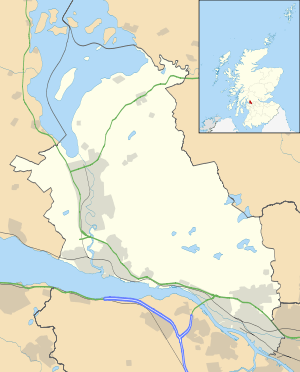 Dumbarton Location within West Dunbartonshire | |
| Population | 20,527 [4] (2001 census) est. 19,990[5] (2006) |
| OS grid reference | NS397759 |
| • Edinburgh | 54 mi (87 km) E |
| • London | 356 mi (574 km) SSE |
| Council area | |
| Lieutenancy area | |
| Country | Scotland |
| Sovereign state | United Kingdom |
| Post town | DUMBARTON |
| Postcode district | G82 |
| Dialling code | 01389 |
| Police | Scotland |
| Fire | Scottish |
| Ambulance | Scottish |
| UK Parliament | |
| Scottish Parliament | |
Dumbarton was the capital of the ancient Kingdom of Alclud, and later the county town of Dunbartonshire. Dumbarton Castle, on top of Dumbarton Rock, dominates the area. Dumbarton was a Royal burgh between 1222 and 1975.[7]
Dumbarton emerged from the 19th century as a centre for shipbuilding, glassmaking, and whisky production. However these industries have since declined, and Dumbarton today is increasingly a commuter town for Glasgow 13 miles (21 km) east-southeast of it. Dumbarton F.C. is the local football club. Dumbarton is home to BBC Scotland's drama studio.
History
Dumbarton history goes back at least as far as the Iron Age and probably much earlier. It was the site of a strategically important Roman settlement known as Alcluith of a province named Valentia.[8] The next record of a settlement in Dumbarton is a record in Irish chronicles of the death of Guret, rex Alo Cluathe ("king of Clyde Rock"), in AD 658.[9]
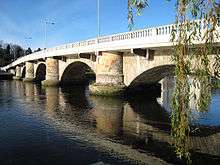
The fortress of Dumbarton was the stronghold of the kingdom of Alclud, and the centre of British power in northern Britain, for more than two centuries from the mid-seventh century, until the Vikings destroyed the fortress after a four-month siege in 870.[10][11] The loss of the British power base led to the emergence of the new kingdom of Strathclyde, or Cumbria, with a major centre at Govan. The title "king of the Britons of Srath Clúade" was first used in 872.[12] Dumbarton was later the county town of the county of Dunbartonshire, formerly known as Dumbartonshire. The name comes from the Scottish Gaelic Dùn Breatainn meaning "fort of the Brythons (Britons)",[11] and serves as a reminder that the earliest historical inhabitants of Clydesdale spoke an early form of the Welsh language.
Alexander II granted the status of Royal burgh in 1222.[10]
In September 1605 Chancellor Dunfermline reported to King James VI that inundations of the sea were likely to destroy and take away the whole town. It was estimated that the flood defences would cost 30,000 pounds Scots, the cost being levied nationwide.[13]
A bridge over the River Leven had been proposed in 1682. The Old Dumbarton Bridge was eventually built in 1765 by John Brown of Dumbarton, at the site of a ferry crossing.[14] It was constructed at the behest of the Duke of Argyll, who was anxious to obtain access to Glasgow from his estate at Rosneath. The bridge, with five segmental arches with rounded cutwaters, resulted in the extension of Dumbarton to West Bridgend. The bridge was substantially developed in 1884 and 1934.[14] It is now B-listed and was refurbished in 2006.
Hartfield House was completed in 1853.[15]
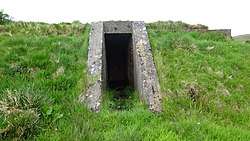
During World War II Dumbarton was heavily bombed by the German air force. The Germans were targeting the shipyards, and the area in the vicinity of the yards was consequently hit, with Clyde and Leven Street being severely damaged. In an attempt to lure the German aircraft away from the shipyards, decoy lights were routinely placed on the Kilpatrick hills above the town, lights were set out on reservoirs to mimic those of the shipyards reflecting on the waters of the Leven and Clyde. The ploy was sometimes successful in diverting the bombers and many bombs fell harmlessly onto the moors and lochs. The Auchenreoch Muir 'Starfish' site above Dumbarton was part of a system of decoy fires operated by the RAF that used pyrotechnics to simulate the appearance of the incendiaries dropped by the German pathfinder aircraft, thereby diverting the bombers from their intended targets. 23 bomb craters are still identifiable in the area around the surviving control bunker as evidence of the success of the diversion.
Castle
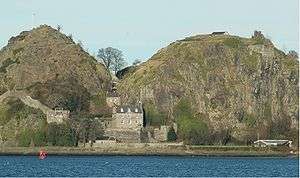
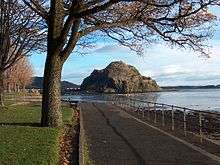
Dumbarton Castle sits on Dumbarton Rock, a volcanic plug dating back 334 million years, at the east bank mouth of the River Leven, where it flows into the Clyde estuary.
The Castle has an illustrious history and many well-known figures from Scottish and British history have visited it. The castle was a royal fortress long before Dumbarton became a Royal Burgh; its ownership went from Scottish to English and back again. The castle was an important place during the Wars of Independence and was used to imprison William Wallace for a short time after his capture by the English.[10] It was from here that Mary, Queen of Scots, was conveyed to France for safety as a child. Mary was trying to reach Dumbarton Castle when she suffered her final defeat at Langside. In later times, Queen Victoria and Queen Elizabeth II visited the castle.
Today, Dumbarton Rock is a Scheduled Ancient Monument; it has legal protection in order to maintain and conserve the site for the future. As such any sort of work on the rock is strictly regulated by the Scottish Government and activities such as climbing on the rock are forbidden. From the top of the castle can be seen both the River Clyde and Leven Grove Park.
Levengrove Park
Levengrove Park was developed in 1885 on grounds of the former Levengrove Estate by the Denny and McMillan families who owned shipbuilding companies with yards located adjacent to the Castle, and gifted to the town.[16]
A grave site in the park sits as the resting place for the viscera of former Scottish king Robert the Bruce. Removal of these "viscera" for local burial was commonplace at the time, when a person's remains were to be transported a long distance for their own burial.[17]
Geography and governance
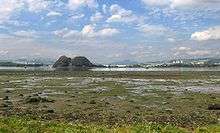
From 1975 Dumbarton lent its name to a local government district in the Strathclyde region of Scotland. In 1996 the administrative functions of this district transferred to the West Dunbartonshire and Argyll and Bute unitary councils (see Subdivisions of Scotland).
Dumbarton town currently serves as the administrative centre of the West Dunbartonshire authority.
There is a Dumbarton constituency of the Scottish Parliament and a former Dumbarton constituency of the House of Commons.
Districts
There are a number of distinct areas within the town:
- Barnhill
- Bellsmyre
- Brucehill
- Castlehill
- Levengrove
- Garshake
- Dumbarton East incl. Newtown
- Oxhill
- Kirktonhill
- Silverton
- Townend
- Westcliff
- West Bridgend
Education
Two secondary schools are located in Dumbarton, namely Dumbarton Academy and Our Lady & St Patrick's High School. The town is also served by eight primary schools; Aitkenbar Primary, St. Michael's Primary, Knoxland Primary, Braehead Primary, St. Peter's Primary, St. Patrick's Primary and Dalreoch Primary.
Economy and transport
Shipbuilding
From the mid 18th century to the early 19th century Dumbarton's main industry was glassmaking. As the glass industry declined the town became a major centre for shipbuilding and remained so well into the 20th century. There were many shipbuilding yards, although a number of them were later absorbed by larger yards. A great many ships were built in the town, the most famous of which is probably the Cutty Sark which was built by Scott & Linton, she was one of the final Tea Clippers to be built, and one of the fastest. The ship is the last survivor of its type and can be seen today at dry dock in Greenwich, London.
William Denny and Brothers
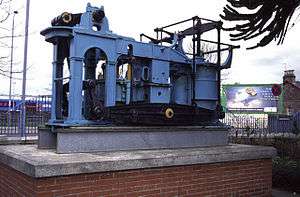
The last major Dumbarton shipyard was William Denny and Brothers which closed in 1963, and the remaining smaller yards followed over the next few decades. Until recently, the old Denny's shipyard tender The Second Snark was still in use on the Firth of Clyde as a passenger ferry and cruise boat. Denny's was an innovative company that had a reputation for research and development; high-pressure turbines and hull stabilisation were two areas where they were highly respected. They even built an early design of helicopter in 1909 and in their final years they were involved in hovercraft development in the form of the Denny D2 Hoverbus. A film clip of this vessel on its maiden trip to Oban exists in the Scottish Film Archive.
The last surviving part of the Denny's shipbuilding company is the Denny Ship Model Experiment Tank which forms part of the Scottish Maritime Museum. This was the first commercial ship model testing tank built in the world and it retains many original features today: a water tank as long as a football pitch, clay moulding beds for casting wax model ship hulls and the original Victorian machinery used for shaping models.
During the Second World War Blackburn Aircraft were to produce Sunderland flying boats from a factory adjacent to Denny's shipyard.
There is still a shipyard on the river Leven, Sandpoint Marina.[18]
The 'Denny Club' was a local social club was named after Denny's shipyard. The club closed down a number of years ago after running into financial difficulties. The club was the sponsor of a local amateur football team, Dumbarton Amateurs, which subsequently changed its name to Denny Amateurs due to the continuing sponsorship and support from the club. Denny Amateurs still play today, and has recently developed a team for younger players in the area, 'Denny Youth', and has provided the new team with strips and equipment along with advice and support.
Whisky
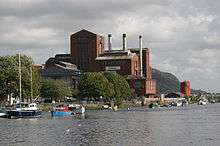
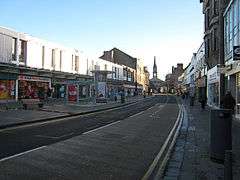
Whisky production also grew to become a major industry in the town. In 1936 Canadian distilling company Hiram Walker bought over the Glasgow-based distiller George Ballantine & Son Ltd. In 1938 they built a large whisky distillery on the river Leven (on the site of the Archibald McMillan shipyard). As a result, the town became known as a major centre of the whisky industry in the mid to late 20th century. Hiram Walker itself was acquired by Allied Breweries in 1988 to form Allied Distillers, itself becoming part of Allied Domecq before eventually being taken over in 2005 by the French-based alcohol giant Pernod Ricard. The large Dumbarton distillery had been mothballed since 2002 and not long after the Pernod-Ricard takeover the giant red-brick buildings of the Dumbarton 'Ballantine's' distillery which had dominated the town for over sixty years were earmarked for demolition and redevelopment, the remains of the distillery were demolished throughout January and February 2017. The large bonded warehouse complex to the east of the town and the bottling complex to the north-west were retained.
Other whisky-related site closures such as the Inverleven distillery which closed in 1991 and the J&B Scotch Whisky bottling plant and bond in the north of the town have contributed to the decline in Dumbarton's importance to the drink industry. However part of the J&B bond has found a new life as a film set for television productions such as 'River City' and 'Still Game'.
Ballantine's Whisky became well known for the rather unusual 'security' guards used at their bonded warehouse complex at Dumbuck in Dumbarton; these are a large flock of white Chinese geese that were first introduced in 1959.[19] Starting with just six individuals, this has risen to close to 100 birds today.[19] They have the nickname 'The Scotch watch' and have been widely used in promotional material for the Ballantine's blended whisky.[19] The geese are part of the tradition of the facility, and are both a tourist attraction and advertising icon.[19] The Goosekeeper at the time (as of 1996) was Arthur Carroll,[19] but as of 1997 they have been replaced by CCTV cameras.[19]
Other industries
With the decline of the whisky industry, Dumbarton is becoming more a commuter town for those who work in nearby Glasgow and other locations. The Faslane naval base is a major employer for the area. The Strathleven Industrial Estate near Dumbarton was once the location of several major manufacturers such as Burroughs (Adding Machines) and Westclox. Technology overtook these companies and they closed down with the loss of many jobs.
The estate has also been the home of Polaroid UK since 1965. This was the largest Polaroid plant outside the US and at its peak it employed about 1800 people. Failing to recognise the impact of digital photography was its downfall and while they still have a presence in Dumbarton, less than 100 people are now employed there (mainly in the manufacture of sunglass lenses). The generator supplier Aggreko plc has had a facility in the town since the 1970s, in 2012 it opened a new, larger facility at the former J&B plant.
Transport
Dumbarton is situated on the main A82 road, linking Glasgow to the western Scottish Highlands. Dumbarton is a short distance from Balloch pier, where cruises can be taken on Loch Lomond. Dumbarton is also served by three railway stations: Dumbarton Central, Dumbarton East and Dalreoch railway station. All three stations are situated on the North Clyde Line, which provides a direct link from Helensburgh in the west, through Glasgow Queen Street to Edinburgh Waverley in the east.
Media
Your Radio, the local commercial radio station for West Dunbartonshire is based in the town, having moved from Clydebank in 2016. It formally was named Dumbarton Festival Radio and then Castle Rock FM until 2003.
The town has two local weekly newspapers, The Lennox Herald and The Dumbarton Reporter.
Culture
Sports
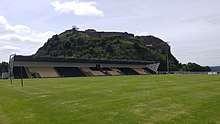
There were at one stage two league football clubs from the town, Dumbarton Harp F.C and Dumbarton F.C (Also known as 'Sons of the Rock'). Dumbarton F.C. are the only league club in Dumbarton still in operation, playing in the Scottish Professional Football League at Scottish League One level.
Dumbarton F.C play home games at the Dumbarton Football Stadium (known since 2018 as the C&G Systems Stadium for sponsorship reasons[20]) adjacent to Dumbarton Rock. They won the 1882–83 Scottish Cup and are five times runners-up.
The Scottish League was formed in 1890 with Dumbarton as founding members. The first championship was shared between Dumbarton and Rangers, in the absence of a goal-difference rule to act as a tiebreaker.
There are seven bowling clubs in Dumbarton: Brock Bowling Club, Dixon BC, Dumbarton BC, Dumbuck BC, Eastfield BC, Rock BC and Townend BC.
The town is the birthplace of the motor-racing driver Sir Jackie Stewart OBE. He competed in Formula One between 1965 and 1973, winning three World Drivers' Championships. The Stewart Family owned and ran the garage at Dumbuck in Milton to the East of the town, the Garage later being taken over by Jackie's close friend John Lindsay.[21]
Arts
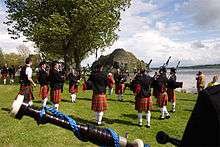
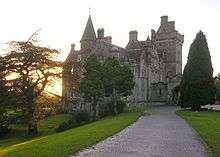
Scottish poet Robert Burns was made freeman of Dumbarton. He refers to Dumbarton in a letter written on 7 July 1787.
- "... I have lately been rambling over by Dumbarton and Inverary, and running a drunken race on the side of Loch Lomond with a wild Highlandman; his horse, which had never known the ornaments of iron or leather, zigzagged across before my old spavin’d hunter, whose name is Jenny Geddes, and down came the Highlandman, horse and all, and down came Jenny and my bardship; so I have got such a skinful of bruises and wounds, that I shall be at least four weeks before I dare venture on my journey to Edinburgh."
Dumbarton is also immortalised in the traditional Scottish song "Dumbarton's Drums".[22]
- Across the fields of bounding heather,
- Dumbarton sounds the hour of pleasure;
- The joy I know will know no measure,
- When Johnnie kneels and kisses me. (one verse)
The song was recorded by the internationally renowned Midgies Ceilidh Band at a live concert in Saint Augustine's Church in the town's High Street, the chorus being sung by the audience of local people.
Novelist A. J. Cronin's maternal grandfather, Archibald Montgomerie, owned a hat shop at 145 High Street.
Dumbarton is the birthplace of David Byrne, a Grammy Award, Academy Award and Golden Globe-winning musician best known as the founding member and principal songwriter of new wave band Talking Heads.
Glaswegian band Franz Ferdinand released a remix of their hit song, "Take Me Out" called "David Byrne Was Born in Dumbarton" which heavily sampled the Talking Heads song, "Burning Down the House".
Royal Scottish Pipe Band Championships
Held in Dumbarton since 2000, the Royal Scottish Pipe Band Championships sees over 140 bands enter yearly, including representatives from Sweden, Denmark, Netherlands and Ireland. The championships is one of the biggest and most prestigious pipe band events in the world. Besides the pipe band championships there is a funfair and Highland dancing competitions.
Theatre
The Denny Civic Theatre is used by a number of local groups, including the Dumbarton People's Theatre.
Religion
The following section is an extract from Edward McGhie's "Dumbarton Parish Church in History" (revised in 2004 by David Wilson) which appears on the website of Dumbarton: Riverside Parish Church.[24]
The Early Church
No one can be really certain when the Christian message first came to Dumbarton. The 'Dark Ages', that period following the departure of the Romans from Britain being but rarely, and often inaccurately, recorded. What is certainly known is that Dumbarton was the capital city of an extensive Cymric (Britons) kingdom which stretched from Glen Falloch southwards as far as modern Morecombe. The only westward part of the land outwith the kingdom of Strathclyde was the Galloway peninsula.
The Celtic bishops of Alcluyd
To the Britons, Dumbarton was known as Alcluyd, Alcluid, Alclwyd, Alcluithe, Alclut, all meaning the Rock on the Clyde. To the Gaelic speaking people of the kingdom of Dalriada (roughly corresponding to modern Argyll) the town was known as Dunbretane, Dunbretan, Dumbartane, and finally Dumbarton (the fort of the Britons). The Annals of Ulster contain one of the earliest references to a Christian community in Dumbarton. In 314AD it records that three bishops accompanied by a deacon represented Alcyuyd at a conference in Arles, the former capital of Burgundy in south-east France. Throughout the 6th century frequent references to Alcluyd occur. Again in the Annals of Ulster it is shown that bishops of the Celtic Church were taking their name and style from Dumbarton, As an example, in 554AD the Annals record the death of Cathul MacFergus, Bishop of Alcluyd. At about the same date, in the Episcopus Britannorum, Kentigern, more widely known as Mungo ('the beloved'), is recorded as having gone with his monks from Glasgow to Alcluid, 'where they laboured with great diligence among the people'. In the 6th century Modwenna, an Irish princess, endowed a chapel, dedicated to St Patrick, on the south side of Dumbarton Castle. Bede in the 7th century refers to Alcluyd as a 'well fortified city'.
The 'crusader' stone
One, perhaps conclusive, piece of evidence of a church on this site was the discovery in 1848, when installing heating pipes under the floor, of a gravestone featuring a cross and a sword. It lay north/south and formed part of the flagged passage at the east end of the church. Donald Macleod, the well-known local historian, concluded that it appeared to belong to the Crusades period of history – the late 11th or early 12th century. Aisles of churches have long been used for burial and therefore a church must have stood here in the 11th century. Certainly it would be reasonable to assume that when King Alexander II granted royal burghal status in 1222 to 'his new town beside his castle at Dumbarton', there was already a well-established church.
Kilwinning Abbey
Dumbarton Parish Church was 'apportioned' by Robert de Brus to Kilwinning Abbey in 1320. The church was confirmed to the use of the abbey by John, Bishop of Glasgow in 1325 and by the Chapter of the same in 1330. Papal confirmation followed in 1329 and 1332. It is worth noting that burgh accounts show that both the parsonage and vicarage 'fruits' still pertained to Kilwinning Abbey at the time of the Reformation, indeed and rather inexplicably the records show payments still being made to Spottiswoode of St Andrews, Commendator of Kilwinning, years after the Reformation.
The Old Parish Kirk
Although we know little of the first church built of this site, it was probably of the same size and structure as the ruins of Cardross Parish Church in Levengrove Park, we know much more about the one the present building replaced. The first entry in Dumbarton burgh records that refers to the Parish Church is dated 1372. It refers to a deed engaging Patrick de Greym, heir to David de Greym (Dominus de Dundaff) 'to support a chaplain of the rood altar in the parish church of Dumbarton for the soul of Isabella Fleming'. 'Quod Omnia de Dalnottar'.
The buildings and altars
This (second) church had a broad tower surmounted by a short spire and weathercock. The 'T' shape at the east end was caused by 17th-century south transept enlargement of the burial vault of the Lords of Kirkmichael which was paid for by Robert Semple of Fullwood and Kirkmichael. Within the church were six altars, each with their own chaplain; St James', the Rood altar or the Holy Cross, St Peter's, St Ninian's, St Sebastian's and the altar of the Blessed Virgin Mary. Town Council as patrons of the Parish Church
In 1617 Spttiswoode, Archbishop of St Andrews, Commendator of Kilwinning Abbey, resigned the Parish Church of Dumbarton along with the patronage, vicarage, and manse in the hands of James VI, in order that it might be conveyed to the Town Council. A charter dated 10 June 1618, granted under the great seal, conveyed to the provost and baillies, Council and community of Dumbarton, the right of patronage, manse etc. and confirmed Spottiswoode's resignation. The terms of the Charter were ratified by Act of Parliament in 1663. In view of the above, an entry in the burgh records is puzzling – '8 January 1670, the thirds part of the year’s patronage payet to the treasurer of the Abbacy of Kilwinning'.
The Parish Church Buildings
Proposed new church
On 9 January 1810 the heritors appeared at presbytery with proposals for a new church. The total cost was estimated at £5,100 with £305 provided by the government in respect of accommodation for soldiers garrisoned at the castle. The architect appointed was John Brash,[25] a then little known Glasgow architect. His first plan was rejected by the heritors as being too large and too decorative. Brash then submitted plans which closely resembled Galston Parish Church which he had already designed. The result was a dignified Georgian church. The steeple is pedimented and on each corner of the gate piers one can see urns that became Brash's trademark, referred to by his fellow architects as Brash's 'Indian clubs'. Yet these urns and the 'pressed in' portico relieves and in a way enhances the classical severity of the front elevation. The interior with his horseshoe balcony was a typical Presbyterian hall church of its time, the only decoration the Presbyterian clock flanked by the burning bush insignia of the Church of Scotland and the burgh coat of arms. Lighting was at first by candles, replaced by gas in 1832 and by electricity in 1912. The original 1811 pulpit was a three 'decker' – minister, reader/precentor and finally 'repentant’s stool'.
Further information about the current church building can be found here.[26]
1972 – Formation of Riverside Parish Church
Riverside was formed following the union of the Old Parish Church, the North Church and the High Church. The sale of surplus buildings facilitated the development of the impressive Halls complex in the early 1970s and the refurbishment of the sanctuary. The complex now boasts 3 large multi-purpose halls; one with a stage, complete with a sound & light system, a games hall and the large rear hall, marked for a badminton court, which can be subdivided. There are a number of smaller meeting rooms; a crèche, lounge, choir room, the church office and vestry, refurbished kitchens, toilets and various stores for the use of affiliated organisations.
Ministers since the formation of Riverside
To 1977 – James F. Dunn (translated to Coatbridge)
To 1977 – Finlayson Niven (died in 1977)
1978 to 84 – James F. Miller (translated to Dunblane, then to the USA)
1985 to 2001 – John B. Cairns (translated to Aberlady w/ Gullane)
2002 to 2010 – Robert J. Watt (retired to Dunfermline)
2010 to 2013 – Eleanor McMahon (translated to St Nicholas Cardonald)
2014 – Ian Johnson
Brief history of St. Patrick's RC Church
Mass had been celebrated in the Dumbarton area from the 1800s. By 1830 there were 500 Catholics and seeing the need for a church, St Patrick opened its doors;[10] being the first post-Reformation Catholic church in the area.
The foundation stone of the new church was laid in 1901 with the formal opening on 22 March 1903. The foundation stone of the tower was laid on 27 June 1926 by Archbishop Mackintosh. The new marble side altars, the pulpit the altar rails, the organ, the mortuary chapel, the tower and its carillon of 23 bells had all been completed by the end of 1927 and with the erection of the Pieta on the marble altar in the basement of the tower the two years' work was brought to a successful termination.
Notable people
- Darian Mackinnon - Footballer
- Douglas Gordon – Artist
- David Byrne – Musician (Talking Heads)
- Marcus Campbell, snooker player
- Zander Diamond – Football player (Aberdeen F.C., Oldham Athletic A.F.C., Burton Albion F.C.)
- Scott Duncan – Football player/manager
- Mountstuart Elphinstone – Historian and civil servant.
- Richard Gilmour, former bishop of Cleveland
- Jimmy McCulloch – Musician (Paul McCartney and Wings, Thunderclap Newman, Stone the Crows)
- John McFall, politician[27]
- Eric Russell, England test cricketer
- Jackie Stewart – Formula 1 racing driver
- David Ward – Opera singer, known internationally for Wagner and Verdi roles
- Prince Harry and Meghan Markle became the Earl and Countess of Dumbarton upon their marriage on 19 May 2018.[28]
- James Cosmo – Actor, known for his film appearances in Highlander and Braveheart and for television series such as Games of Thrones
See also
- List of places in West Dunbartonshire
- Mountstuart Elphinstone, historian and civil servant from Dumbarton
- Scotch watch (geese)
- Milton Island and the Dumbuck Ford
References
- "Ainmean-Àite na h-Alba ~ Gaelic Place-Names of Scotland". Gaelicplacenames.org. Retrieved 30 May 2014.
- Andy Eagle (27 February 2003). "The Online Scots Dictionary". Scots-online.org. Retrieved 30 May 2014.
- "Scots Language Centre: Scottish Place Names in Scots". Scotslanguage.com. Retrieved 30 May 2014.
- "Comparative Population Profile: Dumbarton Locality". Scotland's Census Results Online. 29 April 2001. Retrieved 2 September 2008.
- "Publications and Data". General Record Office for Scotland. Archived from the original on 16 September 2009.
- "Scottish Parliament: Placenames collected by Iain Mac an Tailleir" (PDF).
- "Vision of Britain". Archived from the original on 30 March 2009. Retrieved 4 March 2008.
- Irving, Joseph (1860). The History of Dumbartonshire, Civil, Ecclesiastical, and Territorial: With Genealogical Notices of the Principal Families in the County: the Whole Based on Authentic Records, Public and Private. p. 16.
- "Annals of Ulster".
- Francis H Groome, ed. (1885). Ordnance Gazetteer of Scotland: A Survey of Scottish Topography, Statistical, Biographical and Historical. Thomas C Jack.
- Driscoll, Stephen; Forsyth, Katherine (January 2008). "The Late Iron Age and Early Historic Period" (PDF). Scottish Archaeological Journal. 26 (1): 8. doi:10.3366/saj.2004.26.1-2.4 – via Edinburgh University Press.
- Charles-Edwards, T. M. (2013). Wales and the Britons 350–1064. Oxford University Press. pp. 480–481. ISBN 978-0-19-821731-2.
- Chambers, Robert (1885). Domestic Annals of Scotland. Edinburgh : Chambers. p. 183.
- "Dumbarton, Bridge Street, Dumbarton Bridge". Canmore. Retrieved 14 September 2018.
- "Dumbarton, Latta Street, Drill Hall". Canmore. Retrieved 27 June 2017.
- "History of Levengrove Park". West Dunbartonshire Council. Retrieved 14 September 2018.
- "Burying the Bruce : Scotland Magazine Issue 47". Scotlandmag.com. 16 October 2009. Archived from the original on 7 April 2013. Retrieved 30 May 2014.
- "Sandpoint Marina".
- "Story of the Scotch Watch". Suntory.co.jp. Retrieved 30 May 2014.
- Barrow, Simon (5 May 2018). "C&G SYSTEMS ARE NEW STADIUM SPONSORS". Dumbarton Football Club.
- "Stewart set for Freedom of Dumbarton".
- "Dumbarton's Drums". Traditional Scottish Songs – Dumbarton's Drums. rampantscotland.com. Retrieved 3 October 2010.
- Overtoun House accessed 18 March 2008
- from www.dumbartonriverside.org.uk/about-riverside/parish-church-history accessed 06/05/2015
- "Basic Site Details: Dumbarton Parish Church". Dictionary of Scottish Architects. Retrieved 13 September 2018.
- "Present Church Building". dumbartonriverside.org.uk. Retrieved 3 May 2019.
- "'Consumer champion' MP to stand down". BBC. 29 January 2010.
Prime Minister Gordon Brown ... said "John has been a champion for Dumbarton for 23 years..."
- "Queen gives Prince Harry the title Earl of Dumbarton". BBC Scotland News. BBC. Retrieved 19 May 2018.
External links
| Wikimedia Commons has media related to Dumbarton. |
